Elite athletes use vivid, multi-sensory visualization techniques that engage all senses—sight, sound, touch, smell, and taste—to create realistic mental images. They often imagine performing from a first-person perspective, helping activate brain areas involved in actual movement. Incorporating physical movements and establishing daily routines further reinforce skills. By transforming negative thoughts into positive imagery, athletes build resilience. Keep exploring to uncover more strategies that can elevate your mental game and boost your confidence.
Key Takeaways
- Elite athletes use sensory-rich mental imagery, engaging sight, sound, touch, smell, and taste to create vivid, lifelike scenarios.
- They visualize from a first-person perspective to enhance realism and activate neural patterns similar to actual performance.
- Routine visualization practices incorporate movement, breathing, and positive self-talk to strengthen confidence and focus.
- Athletes reframe negative imagery into positive scenarios to boost motivation and resilience during mental rehearsal.
- Consistent mental imagery reinforces self-image, improves motor skills, and prepares athletes emotionally for competition.
Crafting Vivid Multi-Sensory Mental Imagery
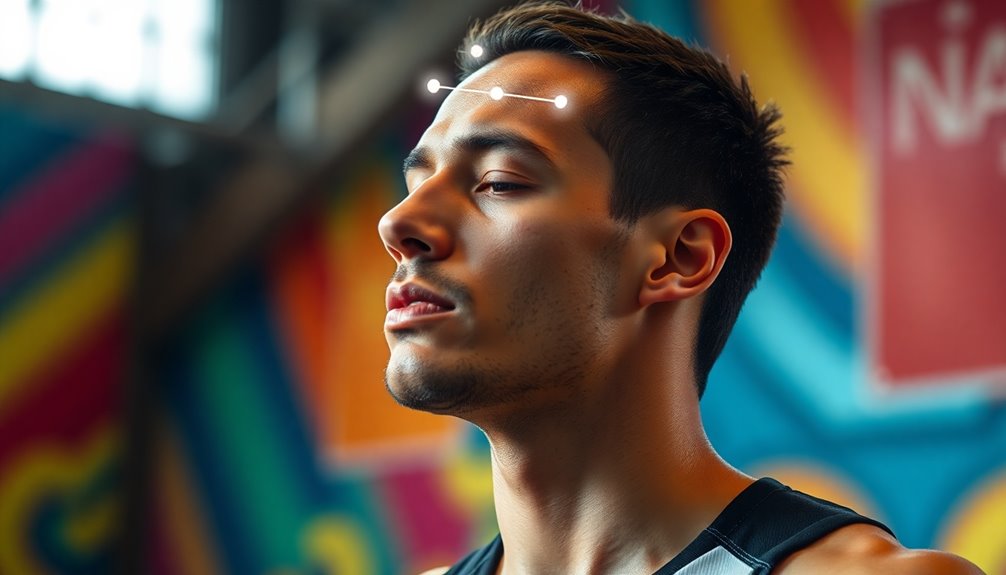
Have you ever wondered how elite athletes create such realistic and powerful mental images? They craft vivid, multi-sensory imagery by actively engaging all their senses—visual, auditory, tactile, olfactory, and gustatory. These athletes include sensory details like the sound of a ball hitting the racket, the scent of the environment, or the feeling of muscle tension to make their mental scenes more lifelike. They also simulate movement and physical sensations to deepen immersion. Regular practice helps improve their ability to conjure detailed, realistic images that feel almost real. This vividness boosts confidence and focus, allowing athletes to mentally rehearse their routines with precision. The more they practice, the sharper their mental imagery becomes, giving them a significant edge in competition. Additionally, research supports that 16PF provides detailed insights which can help athletes tailor their visualization techniques to enhance performance.
Adopting a First-Person Perspective for Realism
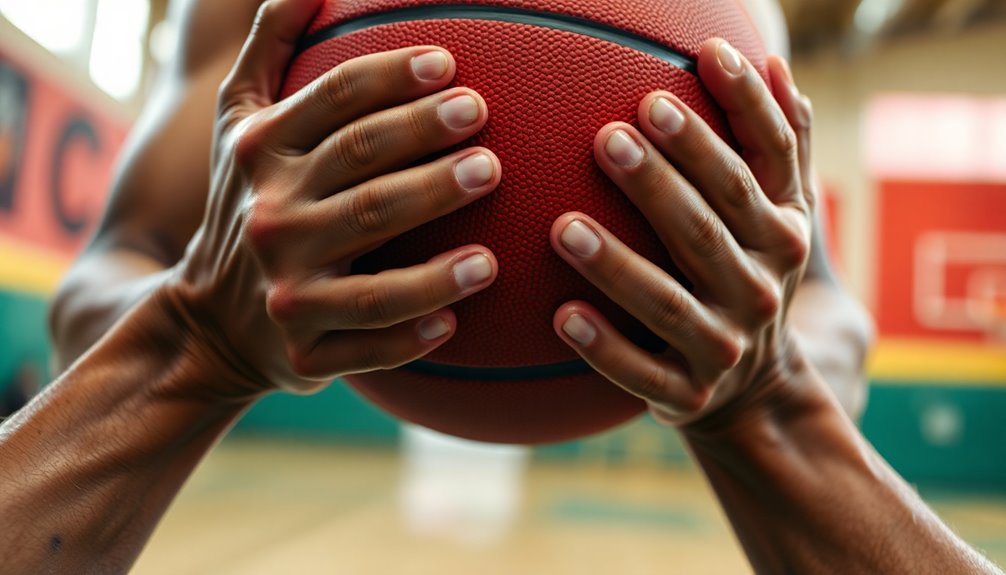
Adopting a first-person perspective in mental imagery considerably enhances the realism of visualization for athletes. When you see the scene through your own eyes, you activate your motor cortex, making neural patterns similar to actual performance. This perspective helps you simulate muscle movements and timing more accurately, especially for dynamic skills like tackling or complex maneuvers. It also boosts emotional engagement, making the experience feel more authentic, which can evoke the feelings of pressure, excitement, and focus. Incorporating all senses—sight, sound, touch, and even smell—further immerses you in the scene, reinforcing memory and execution. Elite athletes use this perspective to prepare both physically and mentally, embedding procedural memory and sharpening their readiness for competition.
Integrating Physical Movements With Visualization
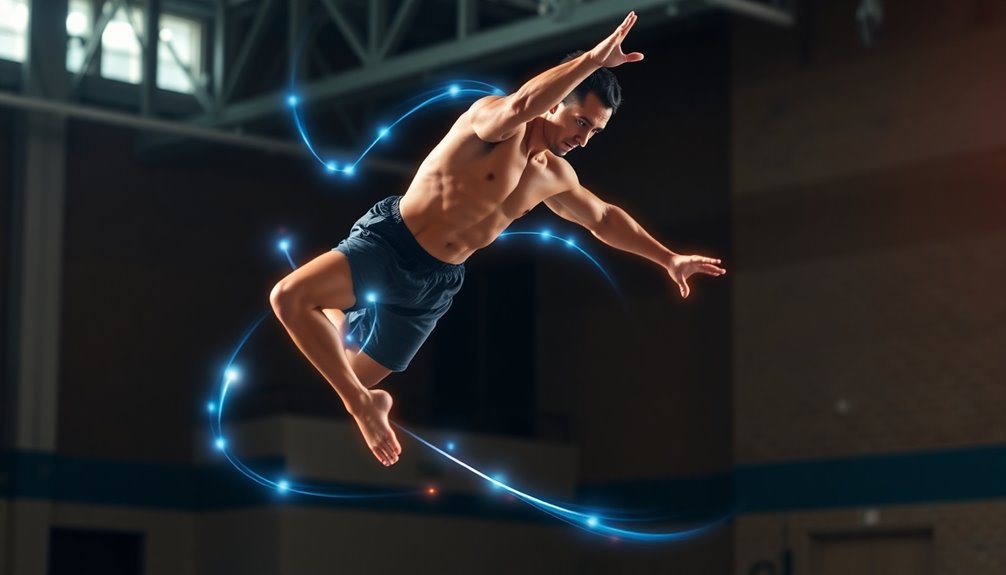
Building on the immersive power of first-person visualization, integrating physical movements amplifies the realism and effectiveness of mental practice. When you move physically while visualizing, you create a richer sensory experience that boosts neural engagement and motor skills development. This approach strengthens neuromuscular connections, improving muscle memory and coordination. Physical movements also provide immediate feedback, allowing you to adjust and refine your technique on the spot. Additionally, incorporating movement evokes emotions, making your visualization more impactful and enhancing emotional readiness. For example, mimicking the motions of riding an electric dirt bike can improve balance and control, much like the horsepower of electric dirt bikes enhances off-road performance. By combining mental imagery with physical actions, you reinforce neural pathways and boost performance consistency. This method helps you execute skills more effectively under pressure, ultimately making your mental rehearsal more dynamic, realistic, and beneficial for competitive success. Furthermore, aligning physical actions with visualizations can activate the same brain regions involved in actual movement, increasing the effectiveness of mental practice. Engaging in these combined techniques can also be influenced by sustainable fashion practices, emphasizing mindful and eco-conscious training methods. Incorporating proper recovery techniques ensures your body adapts well to this integrated approach and reduces injury risk. Additionally, integrating mindfulness practices during physical movements can deepen focus and improve overall mental clarity during training.
Establishing Daily Mental Rehearsal Routines
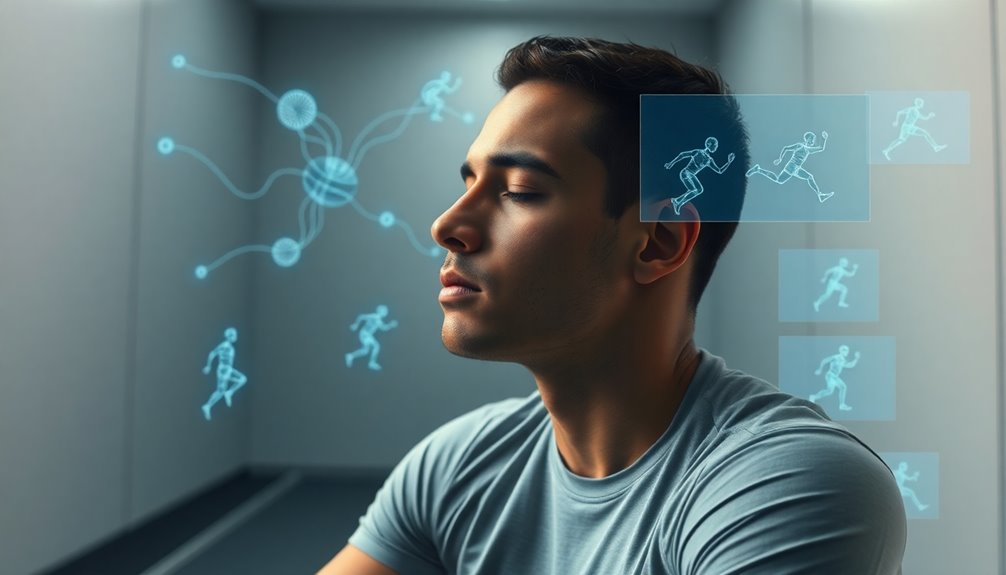
Establishing a daily mental rehearsal routine is essential for maintaining focus and readiness in your athletic performance. Consistency is key, so set specific times, like mornings or evenings, dedicated to visualization. This habit helps you stay mentally sharp and prepared for various situations. Integrate visualization with techniques such as controlled breathing and positive self-talk to bolster mental toughness. Visualize different scenarios, including unexpected challenges, to build resilience. Regularly review your routines, making adjustments based on performance feedback to ensure continuous improvement. Incorporate these sessions into your weekly training plan, using pre- and post-workout visualization to enhance focus and reflection. On rest days, keep mental sharpness by practicing visualization, preparing you for upcoming competitions and enhancing overall mental readiness.
Using Guided Imagery for Skill Refinement
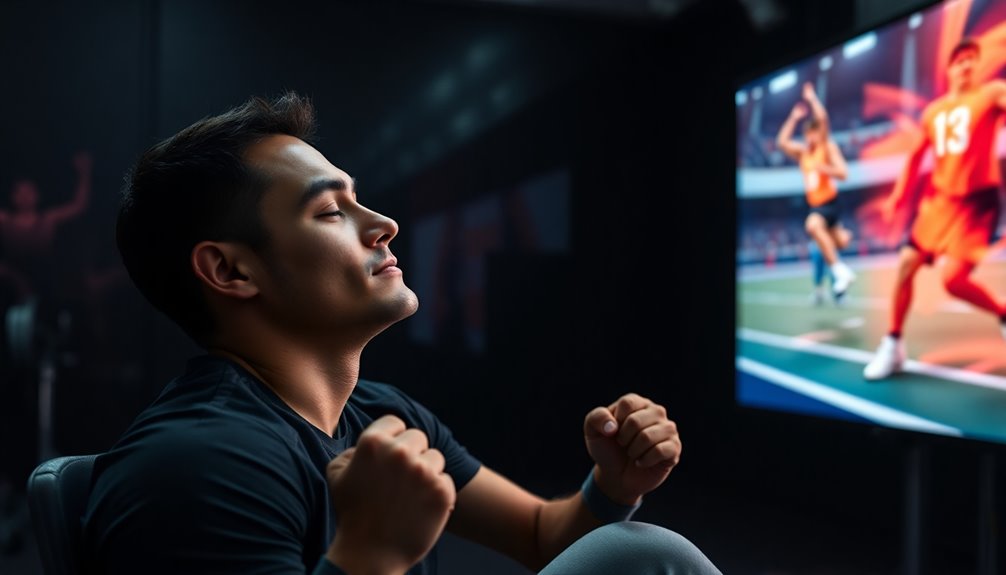
Guided imagery serves as a powerful tool for skill refinement by allowing you to mentally rehearse specific technical, tactical, and physical demands of your sport. By customizing your imagery, you address your unique needs, improving your ability to control mental images and build confidence. Visualizing detailed scenarios sharpens muscle memory and sensorimotor skills, making actions more automatic during competition. Rehearsing tactical decisions enhances your flexibility and decision-making under pressure. The sensory-rich aspects of imagery—visual, kinesthetic, auditory—deepen your internalization of movements, leading to better precision and coordination. Engaging emotions through guided imagery boosts focus and resilience, helping you manage anxiety and setbacks. This personalized mental training strengthens neural pathways, ensuring consistent, refined performance when it matters most. Additionally, incorporating mindfulness and presence can improve your overall mental clarity and focus during both practice and competition. Recognizing the importance of local business hours can also help athletes plan their routines around available training facilities and resources. Furthermore, understanding the role of vetted techniques can optimize your mental imagery practices for better results. Incorporating mental discipline techniques can further enhance your ability to stay focused and committed during training sessions. Moreover, integrating knowledge from sound healing science can deepen your mental visualization, making it more immersive and effective.
Focusing on Outcome-Oriented Visualization Strategies
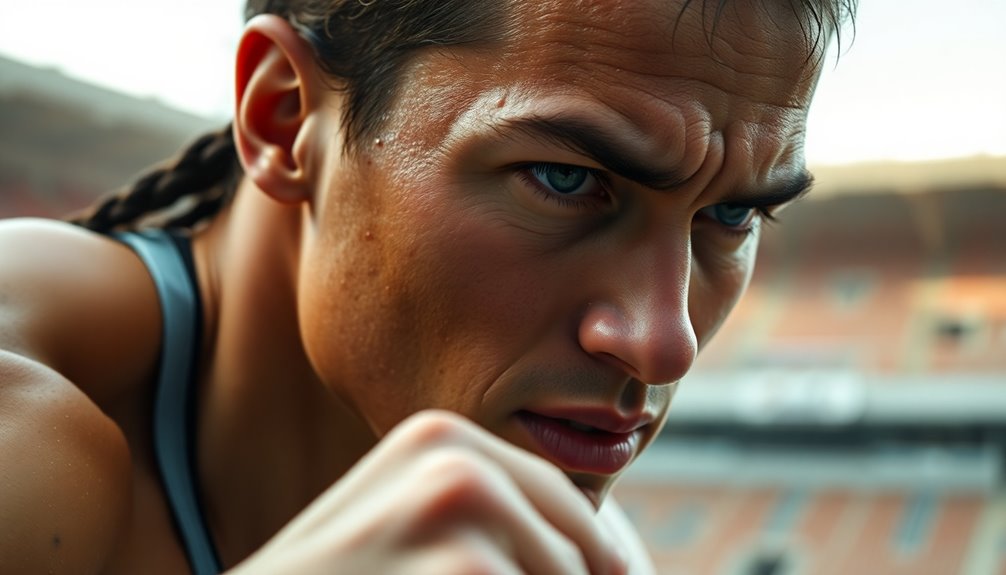
While mental rehearsals of specific skills sharpen your technical and physical abilities, focusing on outcome-oriented visualization strategies takes your mental preparation to the next level by emphasizing success. By visualizing winning, setting personal records, or reaching key milestones, you boost your confidence and mental resilience. This approach helps you stay focused under pressure, mentally preparing for different scenarios you might face in competition. Elite athletes like Djokovic, Phelps, and Serena Williams use outcome visualization to create a clear mental blueprint for success, giving them a competitive edge. Techniques such as vivid imagery, positive affirmations, and realistic scenario simulation reinforce your focus and motivation. Adopting outcome-oriented visualization enhances your performance, reduces anxiety, and builds resilience, ultimately increasing your chances of achieving your goals. Understanding water efficiency and toilet flushing mechanisms can also help you develop a disciplined mindset that supports your training routines. Additionally, recognizing the importance of mental resilience can help you maintain focus during setbacks and setbacks. Incorporating mental training techniques like visualization into your routine can further solidify your mental readiness. Moreover, integrating these practices with goal setting can help clarify your objectives and track your progress more effectively.
Overcoming Negative Imagery and Reinforcing Positivity

Have you ever noticed how negative images can sabotage your confidence and performance? Recognizing these thoughts is the first step to overcoming them. You can reframe negative ideas into positive, constructive ones using cognitive restructuring, helping you stay focused under pressure. Developing emotional regulation strategies, like mindfulness, keeps you present and resilient. Grounding your visualization in realistic goals prevents unrealistic expectations that fuel doubt. To reinforce positivity, use positive self-talk and engage all your senses during imagery—sights, sounds, feelings—to make the experience immersive. Repeating these practices regularly builds confidence and emotional strength. Incorporating protective styling benefits can also support your mental well-being by reducing stress related to hair concerns. In group settings, team visualization and peer support foster collective positivity. Incorporating Glycolic Acid Benefits can enhance skin confidence, which positively impacts overall self-image. Additionally, understanding the importance of Cookies and Privacy helps you feel more in control of your online environment, contributing to peace of mind. Recognizing the role of mental resilience strategies can further empower you to handle setbacks with greater ease. In fact, recent developments in AI security highlight the importance of trustworthiness and safety measures to maintain confidence in digital tools. With consistent effort, you can turn negative imagery into a powerful tool for motivation and success.
Frequently Asked Questions
How Long Should Each Visualization Session Typically Last?
You’re probably wondering how long each visualization session should last. Typically, 10 to 15 minutes daily works best for most athletes. Starting with shorter sessions helps build your mental stamina, and consistency matters more than length. Focus on vivid, purposeful imagery, and relax before each session for better results. Even brief daily practice adds up over time, enhancing your skills and confidence without overtaxing your mind.
Can Visualization Replace Physical Practice Entirely?
Can visualization replace physical practice entirely? Think of your body as a finely tuned engine—you can’t just imagine the ride and expect it to perform perfectly. Visualization boosts your skills, confidence, and focus, but it can’t replicate muscle memory, endurance, or physical conditioning. You need actual practice to develop neuromuscular adaptations and prevent injuries. So, use visualization as a powerful supplement, but never as a complete substitute for physical training.
What Are Common Mistakes to Avoid During Mental Imagery?
When practicing mental imagery, you should avoid common mistakes like having unclear goals, which can make your visualization ineffective. Don’t neglect emotional involvement; strong feelings make the images more impactful. Practice consistently to build confidence, and steer clear of negative imagery that fosters doubt. Also, don’t forget to integrate physical practice with your visualization. By avoiding these pitfalls, you’ll enhance your mental rehearsal and improve your overall performance.
How Early Should Athletes Start Using Visualization Before Competition?
You should start using visualization weeks or even months before your competition. Beginning early allows you to build confidence, reduce anxiety, and improve consistency. Make it part of your daily routine to reinforce skills and mental toughness. The sooner you incorporate visualization, the more it benefits your performance by enhancing focus, strategy, and emotional resilience, giving you a strong mental edge when it’s time to compete.
Are There Specific Techniques for Athletes With Limited Visualization Ability?
You wonder whether specific strategies suit athletes with limited visualization skills. To help, start small—focus on simple, sensory scenes and break skills into manageable steps. Calm your mind with relaxation, then gradually add details. Use physical anchors like breathing or familiar sounds, and incorporate multisensory cues. Guided scripts, mental cues, and consistent routines create clarity, helping you build confidence and competence in mental imagery, even if your visualization feels initially elusive.
Conclusion
By mastering these visualization techniques, you can boost your performance just like elite athletes. Did you know that athletes who practice mental imagery improve their skills by up to 20%? Incorporating vivid, multi-sensory images and daily routines helps you stay focused and confident. Don’t let negative thoughts hold you back—reframe them with positivity. Start today, and watch how your mental game transforms, bringing you closer to your goals every step of the way.









